Category: Digital Humanities
A Journey through Photographs
As a young couple, Zdzisław and Antonina married in the turbulent year of 1938 in Lwów, Eastern Poland, before the outbreak of World War 2. Zdzisław, a fighter pilot in the Polish army, was seized and sentenced by the Soviet Army to imprisonment in the Siberian Labour Camps, the Gulag, in 1939. In September of that same year, Lwów was overtaken and absorbed into the Ukrainian Soviet Socialist Republic and Antonina found herself, with many other citizens, deported east into Siberia.
They spent years of enforced labour in the system with no contact or knowledge of each others’ fates. A treaty in 1942 oversaw the release of a number of Poles from the Gulag system, Antonina and Zdzisław amongst them. As soldier and nurse, Zdzisław and Antonina, respectively and separately, travelled and worked with the Allied Forces. One day, via the Red Cross, Zdzisław heard news that a unnamed family member had been located in Iraq. He travelled there to find his wife Antonina waiting for him.
This visual narrative documents the couples’ earlier years, their joint story, their long awaited reunion, the time they spent traveling with the Allied Forces thereafter, and their eventual resettlement in Ireland where they found their new home.
Curated Data-Driven Narrative
There are two goals when presenting data: convey your story and establish credibility. Edward Tufte
The objective of this project was to analyse data from publicly available datasets in order to set a narrative in motion with visualising accompaniment. The Central Statistic Office’s 2017 introduction of an online application based around baby names in Ireland served as inspiration for this assignment. My paternal grandparents were Polish and moved to Ireland shortly after World War 2. In keeping with Polish tradition, my parents christened me Antonina in 1979, and my brother Karol in 1981. Both were highly uncommon names in that era in Ireland. In more recent years, I have noticed an increase in the names Antonina and Karol in today’s society. This assignment will focus on these two names and measure the popularity of their usage over the years in Ireland. In tandem, it will examine and chart the presence of Polish people in Ireland. These findings will be presented side by side and connections will be illuminated, and any outliers or factors that arise along the data journey will be examined.
Thanks to the popular and intuitive CSO application of Baby Names in Ireland, there is significant data on hand pertaining to the subject. It was necessary to filter down the Girls/Boys Names in Ireland with 3 or more Occurrences by Name, Year and Statistic (1964 – 2017) datasets to specific boundaries of name (Antonina and Karol) and time limit. The parameters of 1970 to 2017 were chosen, as any years previous to 1970 proved redundant in nature due to lack of relevant data. This data was then downloaded in a CSV format and structured within the Excel file so as to prepare it for the visual rendering process. Experimentation with Tableau, Datahero, Voyant and RAW’s various capabilities was an educational exercise in emphasizing the manner in which various tools are undeniably suited for specific data and purposes. Ultimately, Datawrapper proved to be a best fit for the purpose of the data being interrogated and showed itself to be an intuitive and user/reader friendly option. The column format below was chosen in an initial analysis of the data for its ability to display the information proportionally and convey to the audience concrete numbers of names in a given year.
Fig. 1: Babies named Antonina from 1970 – 2017 in Ireland. Get the data here.
Fig. 2: Babies named Karol from 1970 – 2017 in Ireland. Get the data here.
Information on the numbers of Polish people within Ireland over the same time period proved to be more elusive in nature (concrete data on the years prior to 2000 proved impossible to locate) and the decision was made to base the interrogation upon allocation of PPS numbers in the State. Data.gov.ie acts as a portal for the Department of Employment Affairs and Social Protection page which grants access to data on the allocation of PPS numbers via a collective chart of non nationals, ranging from 2000-2009 and, individually, the years thereafter. It was necessary to mine the data pertaining to Polish nationals into one complete Excel sheet. In order to create a streamlined comparison for this study, and operating on a position of full disclosure and transparency, the decision was taken to include the earlier years of 1970 – 2000 and enter these years as null of entries, as seen on Fig. 3.
Fig. 3: Allocation of PPS numbers to Polish people, 1970 – 2017. Get the data here.
The resulting data from Fig. 1 shows that there were no babies registered Antonina in 1979. The name falls under what the CSO deems a “limit of discretion/uncertainty” indicating that there were 3 or less babies named thus in the years preceding 2007 and the name was duly omitted by the CSO due to confidentiality reasons. 2007 witnesses the entry of Antonina into the chart, with 8 females being registered that year. 2017 sees the name peak in popularity at 19.
More variation is evident in the second visualisation, Fig. 2, which sees a significant spike in popularity in the name Karol, evident in 1979, which then continues over several years before waning in existence and re-emerging again in 2005 in a steadier guise.
Fig. 3 demonstrates the economic impact of EU membership on the number of Polish in Ireland over the years. 2004 saw Poland gaining EU membership, and Ireland granted Poland full access to the labour market at this time. The inflow of Polish entering Ireland peaked in 2006 at 93,787 and until the recession in 2008 numbers of Polish in Ireland accessing PPS numbers remained relatively high and sustained.
The use of line graph in Fig.’s 4 and 5 is conducive in showing the shape of the trends over time. The dual peak in popularity of both names is undeniable over the time period between 2004 and 2017. This peak is observed in a similar manner in Fig. 5 which visualises the arrival of Polish people on the shores of Ireland. The striking similarity of the data, seen through the narrative structure of the line graph, holds statistical significance and establishes connection between the occurrences.
Fig. 4: Comparison of Antonina and Karol from 1970 – 2017
Fig. 5: Allocation of PPS numbers to Polish people in Ireland 1970 – 2017
An interesting outlier is evident in the earlier years of Fig. 2 and Fig. 4 and warrants further attention. An examination of the events in Ireland at that time points to a link between the visit from the Polish Pope John Paul II (Karol Jozef Wójtyla), in 1979, and the peak in the name Karol. The Papal visit had huge impact upon the people of Ireland and this is certainly reflected in the choice hundreds of Irish families made in naming their baby boys this uncommon name for the time. This impact is concretely supported by the data and corresponding visualisation. The name Karol lingered in residual popularity for several years following 1979, before the visit faded from the public consciousness to some extent, and the name shows a sharp downturn in usage in 1984.
Additionally, in Fig. 2 and Fig. 4, a more subtle increase may be witnessed further within the second spike in popularity (after the advent of the Polish arrival in Ireland) in the popularity of the name Karol. This outlier may well have remained undetected without the aid of this visualisation. In the year 2011, we see a significant increase in the presence of the name. An investigation into cultural events at the time points to a specific influence in this respect. The formal beatification of Pope John Paul II took place in 2011 and appears to influence the baby naming choices of the year. While it may be said that the spike is significantly minor so as not to lead to a solid conclusion, it would be negligent not to highlight the finding in light of its relevance to this project.
Data visualisation expert Edward Tufte famously critiqued the adage “Correlation does not imply causation.” The peak in popularity of the name Karol seen in the years surrounding the Papal visit is highly evident. The increase in registration of the name in the year of the beatification, combined with the fact of the Pope’s Polish heritage and the presence of a Polish population in Ireland, highlights a subtle further correlation and implies causation between certain baby naming practices and Papal influence in Ireland in this instance.
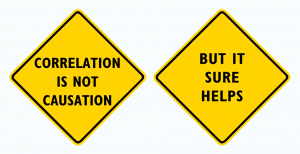
Finally, in order to further emphasise the definitive influence of the 1979 visit upon baby names in Ireland, a supplementary investigation into two additional names was conducted.
Fig. 6: Babies named John/Paul from 1970 – 2017 in Ireland.
The line graph evident in Fig. 6 demonstrates the popularity of the names John/Paul, and the spikes in popularity seen in Fig. 6 directly mirror the arc of the name Karol across the same years as seen in Fig. 4, indicating, once again, the influence the Papal visit exerted. Tufte states “Empirically observed covariation (correlation) is necessary but not a sufficient condition for causality. Correlation is not causation, but it sure is a hint.”
In charting the popularity of specific names over a time frame in Ireland, and placing them in the context of economic and cultural shifts and occurrences, this data story has elucidated some specific instances of influences upon baby naming practices in society. Additionally, it showcases the manner in which large datasets may be mined and rendered in order to produce engaging narratives and visualisations for a wider audience.
References
“Baby Names of Ireland.” Central Statistics Office. www.cso.ie/en/interactivezone/visualisationtools/babynamesofireland/ Accessed 15 Feb. 2018.
Brule, Joshua. “A causation coefficient and taxonomy of correlation/causation relationships.” Semantic Scholar, 05 Aug. 2017. pdfs.semanticscholar.org/7cdf/8ae48c7191130b8c19b17ec1af4a9a0a9e9c.pdf. Accessed 18 Mar. 2018.
“Design Principles.” Data Depiction. datadepiction.wordpress.com/design/ Accessed 17 Mar. 2018.
Edward Tufte. www.edwardtufte.com/tufte/ Accessed 10 Mar. 2018.
“Enrich your story with charts, in seconds.” Datawrapper. www.datawrapper.de/ Accessed 14 Mar. 2018.
“Statistics on Personal Public Service Numbers Issued.” Department of Employment Affairs and Social Protection, 22 Mar. 2017 www.welfare.ie/en/Pages/Personal-Public-Service-Number-Statistics-on-Numbers-Issued.aspx Accessed 16 Feb. 2018.
Crowdsourced Spatial Participation
Today’s world sees us connected as a whole in ways we could never before imagine, allowing us to contribute and participate collaboratively in an increasingly more immediate manner. Clay Shirky, in his TedTalk, “How Cognitive Surplus Will Change the World”, terms Cognitive Surplus as the free time people have on their hands to engage in these collaborative activities. There exists within these efforts a potential to create civic value. Missing Maps is a collaborative project between the Red Cross, Doctors Without Borders (MSF) and the Humanitarian OSM team. It is a project that acknowledges the abilities of the crowd and facilitates the application of the principles of crowdsourcing and open data in bridging the gap that exists between humanitarian organisations and the vulnerable in areas which are inadequately mapped. Various projects Missing Maps have initiated showcase this culture of generosity with incredible effect. James Surowiecki in ‘The Wisdom of Crowds’ elaborates on how the many are smarter than the few, and it is this collective wisdom that lies at the heart of projects such as these. (Surowiecki)
An online exploration, via Open Street Map, of the area I was raised in, Fermoy, Co. Cork, is where I chose to embark from in regards to this assignment. I set up an account, located my childhood home, which has since been converted to the local veterinary practice, and slotted this into the cartography of the area. I corrected misspellings of roads and indicated local green areas, pubs, shops and landmarks. I found this to be an interesting pursuit and a gentle introduction to mapping online.
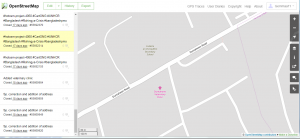
My next step was a straightforward download of MapSwipe onto my tablet. MapSwipe serves as a worthy introduction to the Missing Maps project. It is a micro tasking platform allowing the public to support humanitarian aid in a manner as simple as basic gameplay. The task is the marking of building and roads on tiles of satellite imagery via swiping and tapping your smartphone. However, to refer to MapSwipe in such a simplistic manner serves little justice to this ingenious formulation.
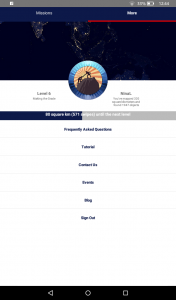
MapSwipe can be installed on your mobile device. It travels with you and adapts to your lifestyle. There is no minimum participation required and every little helps.
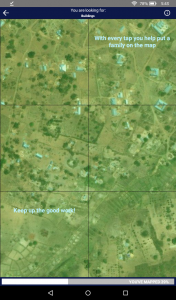
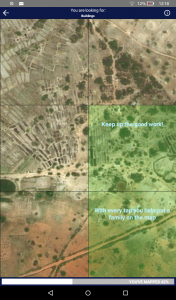
The user brief is elementary. Scan the image for features, tap each tile when you locate the ‘bounty’, tap once for yes, twice for maybe, and three times for obscured imagery. As you swipe through maps of far flung locations, random tiles that you progress through offer words of encouragement and praise your ‘humanitarian’ efforts. There is an element of gamification tied up in the process and this extrinsic motivational technique is conducive in encouraging and maintaining the interest of participants who may have no significant ties to the countries or issues they are engaging with. The user progresses through levels and is given indicators of process. The tiles are later verified by at least three volunteers and graded by agreement so timidity on behalf of the user of fudging results should be discarded. The potential inaccurate grading of a tile is tied into the structure of the application, and this safeguard should perhaps be elaborated upon more in the guiding material for the inexperienced user.
In regards to clarity of the imagery, I observed a few minor issues. Depending on the mobile device of the user, the tiles can appear quite small and having viewed the app on both types of devices, a tablet sized device for true clarity is required. The option to enlarge tiles is farcical, regardless of device. Holding down produces a tile in the middle of the screen that is quite often pixilated in nature and is only a degree or so larger than the original option and of very little help in magnifying the image for clarity.
Ultimately, the accessible user interface and digital engagement of MapSwipe serves as an encouraging introduction to the more insightful and intense environs of Humanitarian OpenStreetMap whereby the user is directed to move to a desktop or laptop platform in order to engage with the tasks. HOTOSM involves an element of drawing (buildings, roads) for which a mouse is essential. I settled upon Project #3952, Malawi – Nsanje, one of the poorest areas in Malawi and one highly dependent on aid organisations. One concise tutorial and the participant is launched into the unmapped territories of various countries in need.
I found the interface of HOTOSM user friendly once I had engaged with the tutorials offered. Projects are delineated according to the skills level of the user and may be filtered along the side to suit ability levels. Each individual project also offers guidelines pertaining to the task and region in question. The task of mapping involves identifying and outlining features, tagging and classifying, and squaring or rounding off of buildings. In dense urban areas, the option exists to split that particular tile down into a more workable size. An issue that arose during my tasking, quite frequently, was that of the pink guiding grid (outside which the user should not map) disappearing when I performed the zoom function on these built up areas. In cases such as these I found myself using main roads and rivers as a point of reference so as to stay within guidelines. Once the user has uploaded their progress, the option exists to have one’s work validated. This is a comforting factor for a new user and once confidence and ability has increased sufficiently, the service of validating others’ tasks is instructive and educational in its own right.
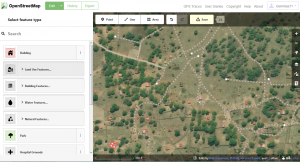
The humanitarian aspect of the Missing Maps project, and the implications any one individual may have on a project or life, is one that I find particularly engaging, and while I remain unsure in how I may introduce aspects of crowd sourced initiatives into my work, I am resolute that I will practice mapping in my personal time. This resolution is brought about through a clear correlation between experiences and stories of friends and mapping initiatives…
I have a personal interest in the Caribbean and the ravages of the various weather elements that its inhabitants are pitted against, particularly during hurricane system. I relocated to the small island of St. John in the United States Virgin Islands in 2003 where I saw the results of 1995’s Hurricane Marilyn still in effect in the homes and hearts of the people there. Over the six years I spent on St. John, I joined my fellow islanders each hurricane season, hunched in front of the Weather Channel, often under strict government issued curfew, anxiously watching a whirling image as it wreaked havoc on our neighbours and willing it away from our path. Hurricane season remained relatively kind to that region from Marilyn up until 2017 which saw Hurricane Irma, closely followed by Maria, truly devastating the area. This mapping assignment has proved personally evocative in opening up a window into the manner we can all help those who are vulnerable to nature’s wrath.
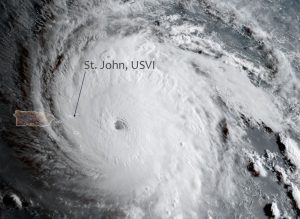
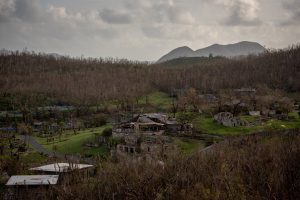
As the days after Irma passed, my thoughts were with friends who lived on isolated dirt roads, in adapted tree houses, atop treacherous mountains, and in the many wooden structures typical of the older style of West Indian building. Power, water, and mobile phone service was all decimated, and a serendipitous Wi-Fi hotspot proved to be a lifeline. Friends and family in the mainland and beyond sent images and maps via an emergency Facebook site manned by those familiar to the topography and people of the island. Volunteers on the ground worked with this information and daily updated, photographed and broadcast on the forum a large cardboard placard with the names of those who had been found safe and those still missing along with maps requesting specific information. A form of modern ‘coconut telegraph’ operation was borne in which the unofficial grassroots efforts of those on the ground collaborated with acquaintances further afield in rescuing and securing aid for the afflicted.
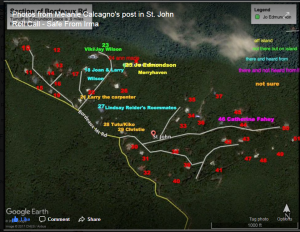
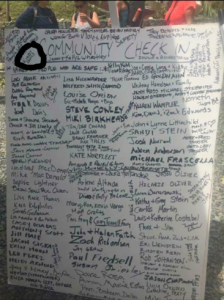
In the following days, approximately 50% of the island were evacuated to Puerto Rico, St. Croix and beyond. In a blow to fate, Hurricane Maria hit on September 16 and incurred widespread damage in areas already affected by Irma, but also decimated the islands evacuees had escaped to. My exploration of HOTOSM in this assignment informed me of the manner in which universities such as Johns Hopkins swung into action in the days following the disaster and organized mapathons where students and staff remotely mapped areas and facilitated recovery and aid efforts. Tyler Radford, HOT’s executive director, estimates that 2,800 volunteer cartographers worked in OSM in response to these hurricanes, adding over half a million buildings. The Puerto Rican relief effort is still currently underway with OSM requiring experienced users with expertise in US road mapping and Java OpenStreetMap Editor currently mapping with high detail the routes and stops of the Publico bus network that are still operating.
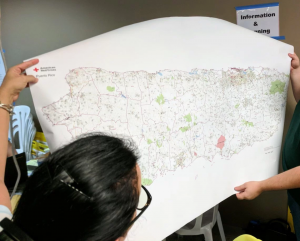
The manner in which technology helped facilitate a grassroots led rescue of personal acquaintances on St. John, paired with the immediacy of HOTOSM’s intervention following the devastation, serves to drive home the significance of crowdsourcing and open source mapping and the very real impact it has, and will continue to have, in peoples’ lives. The argument exists that institutions are outsourcing work via these projects but these particular instances prove to showcase how collaboration with the public elucidates information that official data recorders may not have access to, especially on smaller, more remote locations such as the Virgin Islands that are remarkable in that the community they home consists of diverse characters such as ‘snowbirds’, transient communities, and those living aboard sailing vessels. Local, personal information is key in locating such people.
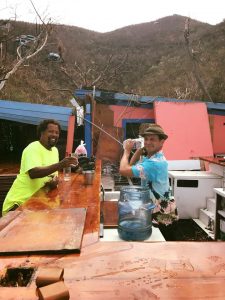
Children who were born in the Virgin Islands and were evacuated as a result of the hurricanes experienced their first winter and snowflakes in 2017 as a result of the catastrophe. What was once a close community consisting of two small villages and one main road has been flung to all four corners of the earth. I believe open source and open data is the way forward in a changing world that has in many ways become smaller. The innate sense of community born in the islands is facilitated via technology daily. With increased online interaction and our ability to travel to destinations unheard of twenty years ago, more and more citizens of the world are coming to the recognition that we are all connected, and we all have influence over each other’s fates, that we are a Global Village. The success of the Missing Maps projects in these areas that I am familiar with significantly demonstrates the manner in which we may positively influence the lives of those less fortunate than us. I am certainly inspired by this assignment to maintain involvement with these initiatives both out of a humanitarian impulse and a sense of personal responsibility. Missing Maps showcases how applications such as these may be incorporated into our everyday life and affect the world and our fellow citizens for the better. The intersection of volunteers, open data and ever improving open source software, in the right hands, holds much promise.
References
“Clay Shirky: How Cognitive Surplus will change the World.” YouTube, uploaded by TEDTalks, 29 June 2010. www.ted.com/talks/clay_shirky_how_cognitive_surplus_will_change_the_world#t-131795 Accessed 09 Feb. 2018.
Day, Katie. “Surfrider Staff Scientist Provides Hurricane Relief in St. John US Virgin Islands.” Surfrider, 07 Nov. 2017. Accessed 01 Feb. 2018.
Kirk, Mimi. “The Crowdsourced Maps Guiding Puerto Rico’s Recovery.” Wired, 13 Oct. 2017. Accessed 11 Feb. 2018.
Oliver-Didier, Jose and Victor Ramirez. “OSM Puerto Rico Emerges Stronger and Ready to Help Rebuild.” hotosm, 27 Oct. 2017. Accessed 01 Feb. 2018.
Peters, Jeremy. “In the Virgin Islands, Hurricane Maria Drowned What Maria Didn’t Destroy.” New York Times, 27 Sept. 2017. Accessed 01 Feb. 2018.
Surowiecki, James. The Wisdom of Crowds. Random House, 2005.
A Clash of Views
Communication experts report that when facts do not fit a specified frame, then the public have difficulty incorporating this data into their mindset. According to Crenshaw, this leads to the stories of an untold many going unreported and disappearing through the cracks, occurrences of ‘injustice squared.” (The Urgency)
Intersectionality challenges the assumption implicit in the mainstream feminist movement that all women co-exist equally and fight the same battles. Grace Hong, a professor of Asian American and Gender Studies at UCLA, says for decades, white women didn’t have to consider any interests beyond their own because “historically, the category ‘woman’ has, implicitly, meant white women.” (Bates) Audre Lorde reports “there is no such thing as a single issue struggle because we do not lead single issue lives.”
Intersectionality may be considered a framework whereby the intersection of many types of oppression can be viewed. While Crenshaw’s immediate focus was related to race and gender “intersectionality has since been expanded to include the analysis of discrimination faced by anyone who identifies with the multiple social, biological, and cultural groups that are not favored in a patriarchal, capitalist, white supremacist society.” (Intersectional) With the onset of social media as a platform where more marginalised voices may be heard, it only makes sense that intersectionality is gaining huge ground in more recent years. The very people it encompasses are finally able to engage in the debate.
Intersectionality is built on sound principle and has undeniable merit in its foundations. However, its passage into the social media arena, and the buzzword type status it has more recently attained, means the term has at times become wrought with confusion and vulnerable to misinterpretation and misappropriation.
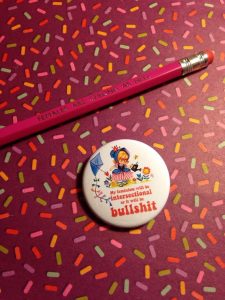
Flavia Dzodan, who identifies as a woman of color, created the infamous phrase “My feminism will be intersectional or it will be bullshit” in her essay expressing her disenfranchisement towards the feminist movement and calling for a change in the way feminism deals with issues beyond gender equality. Her call for action was embraced in a manner that stripped her original message of its context. A consumption of her message by the mainstream feminist movement saw her battle cry become a diluted catch phrase, devoid of the original meaning Dzodan had imbued it with. It was taken by the mainstream and turned into a flimsy, one dimensional version of itself, belying the strong underlying structure of her argument. As a woman of colour specifically, her slogan and rebellion were co-opted and twisted by the mainstream feminist movement to suit their agenda.
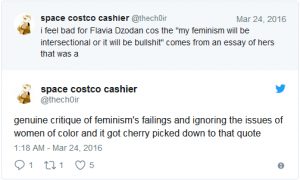
Similarly, Quartz at Work reports how the popular movement #metoo was in fact devised and set in motion by WOC Tarana Burke before being adopted and assimilated into a huge mainstream movement. While Burke is credited with having a place in the movement in Time magazine’s 2017 People of the Year, where the #MeToo movement was honoured, her name is buried deep within the article.
Moments such as these are “the result of the collective labor of women of color who turned private agonies into public battles on behalf of justice. As overdue and welcome as this reckoning feels, there’s also the unsettling reality that a movement built largely on the labor of women of color has been co-opted by a discussion that prioritizes the experiences of victims who are white, wealthy, and privileged over those who are not.” (Purtill)
“Contemporary feminist and antiracist discourses have failed to consider the intersections of racism and patriarchy.” (Crenshaw) A clash of views was witnessed at the AJC Decatur Bookfest’s keynote conversation when writers Roxane Gay and Erica Jong joined together on stage. The evening’s discourse is instrumental in highlighting how advancements must still be made in the relationship between intersectionality and feminism.
Roxane Gay (An Untamed State, Hunger) is a self-described Bad Feminist who has openly criticized mainstream feminism for its failure in acknowledging the needs of the marginalised.
Her fervent support of feminism in a different guise to that which we have traditionally associated it with and her application of the term intersectionality in her highly accessible and empathetic works has seen her star ascend greatly in popularity over the recent years. Erica Jong (Fear of Flying, How to Save Your Own Life) has long been recognized as an icon of the second wave of feminism and had a pivotal role in the sexual revolution.
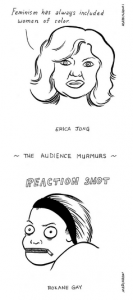
The night quickly descended into an uncomfortable spectacle which saw the old school model pitted against a burgeoning new school of thought in relation to feminism and intersectionality. Jong immediately seemed out of depth and at a disconnect with her audience. She at one point requested clarity in regards to the term intersectionality, a fact which did not go unnoticed amongst the crowd. Tension emerged at Jong’s insistence that feminism has long embraced women of colour into its framework and left the two speakers at a stalemate mid-way, with Gay appearing to quietly demur. Electric Lit relay the night in a graphic comic mode eruditely here and report “the deeper they got into a discussion of racial tensions, the more the backgrounds of these two powerful writers became apparent, both their knowledge and lack thereof.”
If feminism’s goal is to uplift all women, then the inclusive nature of intersectionality should be enveloped in its fold, supporting those women whose simultaneous identities and battles are not always recognized in society. “One-size-fits-all feminism is to intersectional feminism what #alllivesmatter is to #blacklivesmatter.” (Utt and Uwujaren)
The world in which we live is filled with diversity and intersectionality is acknowledging, tackling and embracing this. One aspect of a woman’s identity cannot and should not be prioritized over another for the sake of social or political ease. The odysseyonline reports that “intersectionality is a new wave of feminism that is gaining traction with the Millennial generation.” This new wave is one that threatens to leave stalwarts in dust should their failure to recognise intersectionality’s issues and relevance in our rapidly changing world continue.
Bibliography
Bates, Karen. “Race and Feminism: Women’s March Recalls the Touchy History.” NPR, 21 Jan. 2017. Web. 5 Dec. 2017.
Crenshaw, Kimberlé. “Mapping the Margins: Intersectionality, Identity Politics, and Violence against Women of Color.” Scribd, Web. 4 Dec. 2017.
“Intersectional Feminism for Beginners.” Tumblr. Web. 7 Dec. 2017.
“Kimberle Crenshaw Discusses Intersectional Feminism.” YouTube. Uploaded by Lafayette College, 15 Oct. 2015. Web. 5 Dec. 2017.
MariNaomi. “Speak Up!: A Graphic Account of Roxane Gay and Erica Jong’s Uncomfortable Conversation.” Electric Literature, 10 Sept. 2015. Web. 7 Dec. 2017.
Mejias, Breann. “The Idealised Ideology of Intersectionality.” The Odyssey Online, 11 Apr. 2017. Web. 7 Dec. 2017.
Purtill, Corinne. “MeToo Hijacked Black Women’s Work on race and gender equality.” Quartz at Work, 6 Dec. 2017. Web. 7 Dec. 2017.
“Roxane Gay, Confessions of a Bad Feminist.” YouTube. Uploaded by TEDTalks. 22 June 2015. Web. 3 Dec. 2017.
“The Urgency of Intersectionality- Kimberle Crenshaw.” YouTube. Uploaded by TEDTalks, 7 Dec. 2016. Web. 7 Dec. 2017.
Utt, Jamie and Jarune Uwujaren. “Why Our Feminism Must be Intersectional.” Everyday Feminism, 11 Jan. 2015. Web. 7 Dec. 2017.
“(1982) Audre Lord, Learning from the 60s.” Blackpast, (n.d.). Web. 7 Dec. 2017
@thechOir. “I feel bad for Flavia Dzodan cos the ‘my feminism will be intersectional or it will be bullshit’ comes from an essay of hers that was a.” Twitter, 24 Mar. 2016. Web. 6 Dec. 2017.
@thechOir. “genuine critique of feminism’s failings and ignoring the issues of women of color and it got cherry picked down to that quote.” Twitter, 24 Mar. 2016. Web. 6 Dec. 2017.
Project Proposal
At the core of my research is the story of my grandparents’ experiences during World War Two with specific emphasis placed on their time spent in the Gulag and the aftermath of this tenure.
My grandfather’s name was Zdzisław Lapot and he was born in Warsaw, Poland, on March 5, 1915. At 13, his entire family moved to Lwów, where his father set up a crystal factory and the young Zdzisław began apprenticing in the family trade. He later trained as a fighter pilot before the outbreak of the war.
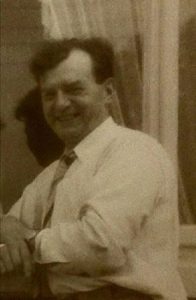
My grandmother was born Antonina Jacek on September 12, 1916 in Ternopil, close to her family town of Lwów. The couple met at a dance in Lwów in 1935. They were a social and well-liked couple and were known to sing their trademark song together at parties. They married the day after Christmas in 1938 in the Roman Catholic church of St. Mary Magdalen in Lwów, Poland.
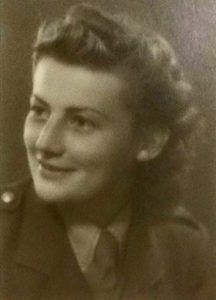
World War Two broke out on September 1, 1939, and Zdzisław was mobilised to fight with the Polish army. Not long after, he was seized for his role and was sentenced by the Soviet Army to imprisonment in the Siberian Labour Camps, the Gulag.
The term Gulag is the acronym for the Soviet Bureaucratic institution, Glavnoe Upravlenie ispravitel’no-trudovykh LAGerei, (Main Administration of Labour Camps) that operated In the Stalin era. Aleksandr Solzhenitsyn published The Gulag Archipelago in 1973, and it was at this time that the term Gulag came to represent this vast concentration camp system.
September of 1939 was a turbulent time across Europe, and Lwów was certainly not spared. The Soviet and Nazi forces divided Poland and Lwów found itself absorbed into the Ukrainian Soviet Socialist Republic. Large numbers of Jews and Poles were deported east into Siberia. Antonina was amongst them. The deportees endured long train journeys. Cramped cattle trucks were fitted out with wooden shelves or bunks and troops packed in as many people as possible. There were sometimes up to seventy people in one trunk, with little or no amenities, for several weeks at a time. The destinations of these trains were some of the most inhospitable parts of Siberia.
At its height, the Gulag consisted of hundreds of camps, each holding 2,000 to 10,000 prisoners. Inmates worked in mines, lumber production and in railway and canal construction. Mining and logging were the most common, and the harshest, activities, and it was in one of these camps that Zdzisław spent almost three years. He endured twenty hour days, cutting down trees in up to five feet of snow, which then had to be hauled tens of miles back to base camp. The men wore mere issued overalls. In particularly harsh conditions, the only concession they were granted was access to petroleum jelly which they were permitted to smear on their faces. Many prisoners lost fingers, toes and limbs to frostbite. Escape was futile. My grandfather recalled to us over the years instances of friends attempting to do so, only in some cases to return to their prisons voluntarily, others did not survive the return at all. Zdzisław and his fellow inmates regularly picked frozen leaves from the trees and smuggled them into camp at night to concoct a soup with the melted snow. Fatality rates ran as high as 80%
Meanwhile, Antonina had been sent to what was termed an ‘Open Village’ where security was not as stringent, but the remoteness and harshness of the environment ensured a natural barrier to escape. She reported on parole, weekly, for a nonexistent crime. Her task was the making of cement blocks with her bare hands. She recalls this work being performed to the tunes of an accordionist who would play on a raised platform above where they worked. Hard labour was payable with scant food supplies and sub-human living conditions. Very few people survived these camps for longer than two years.
Following Operation Barbarossa, the USSR faced its own former ally, Germany, and in July, 1941 signed a treaty with Poland that saw amnesty being granted to the Polish people. Two large scale evacuations took place from March to August 1942, and Zdzisław and Antonina were both released from their respective camps, each still not knowing the fate of each other, or that of their families.
A substantial amount of Polish were sent to Tehran and Antonina was amongst them. She underwent health rehabilitation, trained as a nurse and was sent to Egypt to practice her new skills. Zdzisław was sent for medical treatment in Italy for the ordeals he had endured in the camps, the marks of which he bore with him his entire life. Upon recovery, he underwent intensive training for battle.
At this time, the Red Cross were compiling names from the evacuated Soviet Camps. Zdzisław, having had no news from his wife or family for over three years, heard through the Polish community that his sister’s name had been tracked to a camp in Egypt, and he travelled there to reunite with her. Mass exodus and confusion had led to inaccurate records of names. In bittersweet circumstance, he found not his sister in Egypt, but Antonina.
Together, they travelled with the Allied Forces throughout the Middle East. They were both present at the Battle of Monte Cassino where Zdzisław fought at the mountain and Antonina worked at base camp as a nurse. Harsh conditions saw the couple lose their first child at the base of the mountain. Zdzisław was later awarded the Monte Cassino medal for bravery for his acts on the battle field. A Polish memorial at the base of the mountain cites Feliks Konarski’s anthem Czerwone maki na Monte Cassino (The Red Poppies on Monte Cassino) in tribute to the Polish contribution:
Red poppies on Monte Cassino, | Czerwone maki na Monte Cassino
Instead of dew, drank Polish blood. | Zamiast rosy piły polską krew…
As the soldier crushed them in falling,| Po tych makach szedł żołnierz i ginął,
For the anger was more potent than death.| Lecz od śmierci silniejszy był gniew!
Years will pass and ages will roll, | Przejdą lata i wieki przeminą,
But traces of bygone days will stay, | Pozostaną ślady dawnych dni!..
And the poppies on Monte Cassino | I tylko maki na Monte Cassino
Will be redder having quaffed Polish blood. |Czerwieńsze będą, bo z polskiej wzrosną krwi.
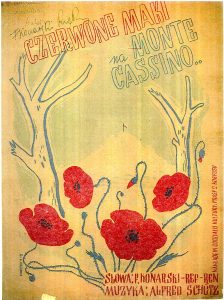
By 1945 over 200,000 Polish troops of the Polish armed forces in the West were serving under the high command of the British army. Many of these men and women were originally from cities in Eastern Poland including Lwów. The Polish Resettlement Act of 1947 offered British citizenship to displaced Polish troops. It was the first ever mass immigration legislation of the Parliament of the United Kingdom. It offered citizenship to over 200,000 displaced Poles and enabled Poles who could not resettle on their native soil for a number of reasons the opportunity to settle in Britain and provide labour.
The couple made the move to London, and from there followed a job lead to Ireland, where Zdzisław found himself in the role of designer and production manager at Waterford Crystal, once again practicing the trade of his family. It was at this time he designed, amongst many other works, the renowned Crystal Swan series.

I feel the reason why I wish to embark on this research is evident. These are narratives that have fallen through the cracks of time and are at a very real risk of disappearing entirely. My grandparent’s story is a small body of delicate history and my aim is to expand it for those who knew my grandparents while they were still with us but were not aware of the intricacies and details of their lives and to also preserve it for future generations. There is a definite sense of regret in my family that we did not explore the story more while they were still with us and with this project I would like to go a little way towards rectifying this .
My research will be divided into a few different areas. My family have relatives remaining in Lublin that we have sadly fallen out of contact with. It is believed that Antonina’s brother returned to Poland post-War and became an actor, while her sister migrated to Canada. To this end, there is a dusty box of correspondence in an attic that must be explored and I am hoping it will produce a solid lead. In Dr. Mike Cosgrave’s Teaching and Learning in Digital Humanities module, I am formulating a class on family tree research and it is my aim that this will aid me in this particular aspect of my research.
I possess a cautious sense that the ideal of building my research 100% around the experiences of my grandparents may be a little ambitious given the information I have to work with, and I am hoping this will change. However, on a broader level, it is my aim to discover which camps and villages were more specific to the conditions they endured and build a narrative around these.
I have compiled a catalogue of readings that recount personal experiences of Poles who were in similar situations. I also hope to source other interviewees willing to speak of their family’s stories in regards to the camps and aftermath. I expect social media and some specific online forums to prove particularly useful in this respect. I am also particularly interested in interviewing Lyudmila Sadovnikova of the Gulag History Museum in Moscow and gaining insight from her perspective on the unique experiences of Poles at the time and also possibly garnering some directives from her expert knowledge.
I recently read Anne Applebaum’s Gulag, a non-fiction book which offers an overview of the Soviet Gulag system and explores human experience within its vast history. In Gulag, Applebaum describes part of her methodology as working with the fictional texts of Russian writer, journalist and poet Varlam Shalamov, his works being based on real events and personal experiences. I am interested in the intertwining of facts and figures with fictional narratives in the re-presenting of my grandparent’s experiences.
As regards to my digital artefact, I would like to convey memory and evoke a sense of family and inheritance. I believe the best manner in which to do this is through the creation of a website. Through discussion with family and friends, I sense the need for my digital artefact to be inherently accessible for a broad spectrum of users, and not overly complicated. I have a strong aim that its interface be friendly towards the needs of an older generation whose interest in it is palpable.
My grandparent’s story is to be the main focus of the site. I intend to digitize their photos, family and official correspondence, documents and personal belongings. This will introduce a personal tangibility and aura to the artefact. Leading off this main focus shall be subsections; synopses of the history of the Labour Camps, elaborations on daily life for inhabitants of the Open Villages and the camps, and experiences for Poles after their release.
I am playing with the notion of creating a simple story map for insertion to the site, documenting my grandparent’s travels from Poland through Siberia, Italy, the Middle East and London, to their final home in Ireland. I expect the practicalities of this to become more evident as I further explore my options in Tools and Methodologies in Semester Two of the course.
In conclusion, I would like to emphasize that I do not intend my research to be focused on history, the Gulag system or repression. I certainly intend to elaborate on these aspects in order to provide very pertinent context to the story I am telling but overall the aim of my research is to record the losses and recount the triumphs of two resilient people against immense obstacles.
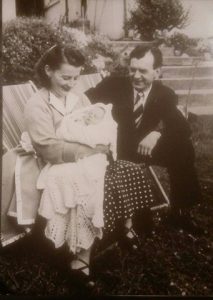
References
Applebaum, Anne. Gulag. Penguin, 2004.
Kizny, Tomasz. Gulag: Life and Death inside the Concentration Camps. Firefly, 2004.
Krupa, Michael. Shallow Graves in Siberia. Birlinn, 2004.
Service, Robert. A History of Twentieth-Century Russia. Penguin, 1997.
Solzhenitsyn, Aleksandr. The Gulag Archipelago. Harper Collins, 2002.
The US Net Neutrality Battle
Sir Tim Berners-Lee’s vision of the Web as an “open platform that would allow everyone to share information, access opportunities and collaborate across geographic and cultural boundaries” is being threatened. Berners-Lee has been calling for the protection of Net Neutrality rules in order to safeguard his vision in light of threatening moves by the Federal Communications Commission in recent times.
Tim Wu, an American lawyer and professor at Columbia, coined the term Net Neutrality in 2003, in his paper Network Neutrality, Broadband Discrimination. Net Neutrality is broadly defined as “the idea, principle or requirement that internet service providers should or must treat all Internet data as the same, regardless of its kind, source or destination.”
In a 2014 speech Barack Obama lauded the basic principles that the internet is built upon; “openness, fairness and freedom” and famously stated that there should exist “no toll roads on the information highway.”
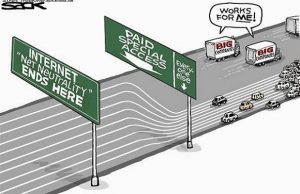
He asked the FCC to recognize that the internet has become, since its inception, an essential part of everyday communication and life, in essence, a utility, and thus should be protected by Net Neutrality, whereby Internet Service Providers (ISPs) are required to treat all data equally. 2015 saw the FCC ruling in favour of Net Neutrality by classifying broadband as a common carrier, a public utility, under Title 2 of the federal communications law.
In 2015, then-Commissioner of the FCC, Ajit Pai (a former lawyer for Verizon) detailed a number of reasons for voting against Net Neutrality rules, a majority of which have since failed to hold water. Ajit Pai has long opposed net neutrality, opining that less regulation in the arena will lead to market growth. Pai was promoted to position of Chairman of the FCC by President Donald J. Trump in January 2017 and the issue has since been raised to the forefront of extreme debate due to the revealing of a draft from the FCC which proposes removing almost every Net Neutrality rule in existence, and allowing ISPs to engage in throttling, blocking and paid prioritization. A final decision is expected at the Commission’s December 14, 2017 meeting.
In two highly entertaining and hugely informative pieces on his Last Week Tonight show in 2014 and 2017, comedian John Oliver suggests that the manner in which the US government and media report on Net Neutrality is, in many cases, deliberately bathed in endless constitutional terms and swathes of legal talk. He smartly observes “if you want to do something evil, put it inside something boring.” This diversionary tactic has turned the everyday consumer off the scent in the past but the recent wave of opposition and attention brought to the term Net Neutrality by a variety of popular figureheads via more accessible social media platforms has begun to turn the tide, engage the general public, and encourage them to argue for their rights.
The Last Week Tonight show created gofccyourself.com, a fast track site leading the public to the FCC’s public comment area where they can voice their opinion. In the short YouTube clip below, Oliver elaborates on the FCC’s seemingly deliberately complicated path towards filing public opinion on their site:
In 2014, after the airing of Oliver’s first dissection of Net Neutrality, the FCC site crashed. The second airing of his opinions on Net Neutrality, and the unveiling of gofccyourself in 2017, saw a similar event occur in regards to the FCC site, with the FCC later denying it was Oliver’s intervention that caused these coincidental glitches in their system.
Ending net neutrality is another step towards the dismantling of freedom and the spectre of controlled media. Content providers, such as Netflix, Amazon and Facebook, alongside independent activists, have aligned themselves against telecom giants such as Comcast and Verizon in this debate. By placing ISPs in the role of gatekeeper over the provision of information and data, the path of knowledge the public can pursue is hindered or channeled and thus future thought processes and developments may be curtailed and controlled. All data must be treated equally. The internet is not a perfect place, and indeed Berners-Lee had never it expected it to be so, but it is a level playing ground. FCC proposals will disrupt this and turn the democratization of the internet on its head.
With time marching on rapidly, the FCC’s determination in regards to the overruling of Net Neutrality rules seems inevitable to succeed. Tellingly, the very day after the FCC announced their plan to dismantle Net Neutrality, Internet Service Provider Comcast, the largest broadcasting and cable television company in the world, reneged on their vow to uphold net neutrality by deleting a ‘no paid prioritization’ pledge from their website. It would appear the wheels are already in motion towards realizing Ajit Pai’s and the FCC’s vision.
References
Berners-Lee, Tim. “I Invented the Web. Here are Three Things We Need to Change to Save It.” The Guardian, 12 Mar. 2017. Web. 1 Dec. 2017 www.theguardian.com/technology/2017/mar/11/tim-berners-lee-web-inventor-save-internet
Brodkin, John. “Comcast deleted Net Neutrality Pledge the same day FCC announce repeal.” Ars Technica, 29 Nov. 2017. Web. 1 Dec. 2017. arstechnica.com/tech-policy/2017/11/comcast-deleted-net-neutrality-pledge-the-same-day-fcc-announced-repeal/
“Net Neutrality: Last Week Tonight With John Oliver (HBO).” YouTube, uploaded by Last Week Tonight, 1 Jun. 2014. Web. 2 Dec 2017. www.youtube.com/watch?v=fpbOEoRrHyU
“Net Neutrality II: Last Week Tonight With John Oliver (HBO).” YouTube, uploaded by Last Week Tonight, 7 May 2017. Web. 2 Dec 2017. www.youtube.com/watch?v=92vuuZt7wak
Mechaber, Ezra. “President Obama Urges FCC to Implement Stronger Net Neutrality Rules.” Obama White House, Nov 10 2014. Web. 1 Dec. 2017 obamawhitehouse.archives.gov/blog/2014/11/10/president-obama-urges-fcc-implement-stronger-net-neutrality-rules
Solon, Olivia. “Tim Berners-Lee on the Future of the Web: “The System is Failing.”” The Guardian, Nov 16 2017. Web. 1 Dec. 2017 www.theguardian.com/technology/2017/nov/15/tim-berners-lee-world-wide-web-net-neutrality
Film, Power Structures and #transformDH
In What’s Next: The Radical, Unrealized Potential of Digital Humanities Miriam Posner outlines some of the ideas on how digital humanities might investigate structures of power, focusing on race and gender. While there is evidence that there is being work done in this direction, she argues that “a dismantling …and rebuilding of the organizing logic is necessary.” It is Posner’s view that we must start recognizing that traditional boundaries such as gender and race are constructions, they have a history and were actively created. They are thus fluid, and may be subject to deconstruction.
#transformdh is about a process of change. It brings into question the framework of digital humanities, and asks: Who is considered in its boundaries of work and how are they represented? Race, gender, sexuality and structures of power are all subject to examination.
Moya Z. Bailey, in All the Digital Humanists are…., broaches the manner in which “identities (that) inform theory and practice in digital humanities have been largely overlooked” and says that by “centering the lives of women, people of colour and disabled folks, the types of possible conversations in digital humanities shift…In re-imagining what counts as digital humanities, we can draw on the wisdom of scholars who have addressed related issues in their own fields of study.” Bailey asserts that there is still a need to challenge the “add and stir” model of diversity and assume that this is sufficient to change “current paradigms.” She rightfully acknowledges that this model does not address the overall structure or encourage any foundational change.
In the afore mentioned article, Posner introduces the work of feminist film theorist Laura Mulvey, whose cinematic work Riddles of the Sphinx serves to demonstrate how the entire structure of film is a construct, and how inequality is written into this structure so inherently that we do not have cause to question it. And as we see how Mulvey dismantled this film and in doing so demonstrated the flaws inherent in the cinematic structure overall, we can see how our social construct may also be subject to the same examination.
Posner asserts “We can do what we know how to do: visualize datasets that we inherit from governments, corporations, and cultural institutions, using tools that we have borrowed from corporations. Or we can scrutinize data, rip it apart, rebuild it, reimagine it, and perhaps build something entirely different and weirder and more ambitious.” (“What’s Next”)
Upon revisiting director Andrea Arnold’s Fish Tank this year, I saw many of Mulvey’s theories from Visual Pleasure and Narrative Cinema reflected in its construct and feel it expounds upon particular calls towards the upheaval of traditional values I have read in my encounters with #transformdh and the views of Miriam Posner.
Fish Tank upends traditional filmic theory and confronts the notion of the male gaze and traditional power structures as elaborated by Mulvey. Mulvey argues that film is bound to a patriarchal structure where women are tied to desire. According to Mulvey, traditional cinema offers voyeuristic, visual pleasure for the cinema goer, subjugating the female. Fish Tank integrates Mulvey’s theories into her work in several ways.
Firstly, it is shot in an almost documentary style. The editing is simple, the timeline is strictly chronological, and there is no interference on behalf of the camera in the action on the screen. The construct of cinema is removed and the audience is placed immediately at edge. This mode places the viewer as co-conspirator, an active role is adopted. The audience traditionally derives pleasure in their guise as ‘invisible guest’ in cinema and Arnold harshly whips away this comfort.
Mia, the female protagonist, is not an image to be ‘looked at,’ she is in control. At one point, she quite literally gazes at a recording of her mother’s partner through the lens of a camcorder. There are several more scenes throughout where this manner of framing is evident.
 The characters’ interactions throughout the screening are also worth remark. From the moment the object of Mia’s attention appears onscreen, he is framed through her eyes. There is no doubt in who controls their personal narrative. There are many shots throughout where he is broken into a tableau of body parts, breaking with the traditional portrayal of entire body of the male in film. In a shot where he puts a ‘sleeping’ Mia to bed, we see her eyes open, aware of his every movement and action. Her perspective is ever dominant.
The characters’ interactions throughout the screening are also worth remark. From the moment the object of Mia’s attention appears onscreen, he is framed through her eyes. There is no doubt in who controls their personal narrative. There are many shots throughout where he is broken into a tableau of body parts, breaking with the traditional portrayal of entire body of the male in film. In a shot where he puts a ‘sleeping’ Mia to bed, we see her eyes open, aware of his every movement and action. Her perspective is ever dominant.
 Andrea Arnold’s Red Road (2006) builds further on this depiction of a strong female viewpoint, where the female protagonist is placed in the role of surveillance agent in her small town. She is literally and figuratively in control of proceedings from her watch room.
Andrea Arnold’s Red Road (2006) builds further on this depiction of a strong female viewpoint, where the female protagonist is placed in the role of surveillance agent in her small town. She is literally and figuratively in control of proceedings from her watch room.
Also worth mentioning is Andrea Arnold’s more general casting brief, which draws largely from non-actors from the area specific to that which she is depicting. Out of the fifteen main actors in her 2016 film American Honey, eleven are non-actors. Posner emphasizes “…we cannot capture these experiences without the contributions of the people whose lives we are claiming to represent. So it is incumbent on all of us (but particularly those of us who have platforms) to push for the inclusion of underrepresented communities in digital humanities work, because it will make all of our work stronger and sounder.” (What’s Next”)
Arnold’s works display the manner in which it is possible to break down structure and specific power arrangements and re-present an alternative way of viewing what we have taken to assume as norm. Posner is of the opinion that digital humanities is “the use of digital technologies to investigate humanities questions.” (“Digital Humanities”) In “What’s Next” she adds “we seem happy to flatten the world into known data structures and visualizations that might easily be reshuffled into a corporate PowerPoint deck…and so what could be more ambitious, more interesting and challenging, than understanding the nature of that power?”
Posner draws attention to the fact that it is so difficult to imagine other modes of representation, should this not ring a warning bell? That these structures seem so indisputable, they must represent great power indeed. It is evident that Posner is calling for a restructuring of these categories that surround us. If we view film as working in the same manner as data does, by taking threads and information and pieces of what we know and reassembling them, then we can see how films such as these serve as optimistic blueprints for change.
References
Bailey, M. Z. “All the Digital Humanists Are White, All the Nerds are Men, but Some of Us Are Brave.” Journal of Digital Humanities, Vol 1, No 1, Winter 2011. Web. 1 Dec. 2017.
Johnson, Sala.”#DirectedbyWomen Mulvey and Scopophilia in Arnolds ‘Fish Tank'”. Screen queens. 14 Sept. 2016. Web. 1 Dec. 2017.
Mulvey, Laura. “Visual Pleasure and Narrative Cinema.” Film Theory and Criticism : Introductory Readings. Eds. Leo Braudy and Marshall Cohen. New York: Oxford UP,1999: 833-44.
Posner, Miriam. “Digital Humanities and Media Studies: staging an encounter.” Miriam Posner. 8 Mar. 2013. Web. 1 Dec. 2017.
Posner, Miriam. “What’s Next: The Radical Unrealised Potential of Digital Humanities.” dhdebates. (n.d.) Web. 2 Dec. 2017.
Whitehouse, Matthew. “Andrea Arnold: How We Cast ‘American Honey’“. i-D, 17 Oct. 2016. Web. 1 Dec. 2017.
Digital Preservation and ‘The Crossing’
A widely misconceived notion seems to be that with the dawn of the digital, what is portrayed through this medium will accompany us into the future, with no expiration date. But where is the guarantee that we will be able to read the news of today on the computers of tomorrow? The 12th International Conference on Digital Preservation was held in November 2015 in North Carolina. Participants were asked why they thought digital preservation was important. The answer is not immediately obvious to the majority of people.
Attendee Alice Sara Prael, John F. Kennedy Presidential Library and Museum, succinctly puts it as such “Our cultural heritage is being saved in digital formats now and it used to be that history was saved by what didn’t get thrown away and that’s not a strategy that works anymore because if we leave our digital (as it is) and hope it will live for another hundred years, it won’t.” (Coursera)
Elaine Harrington, in the UCC October 2017 colloquial, touches on this matter. Researchers are, naturally enough, focused on the research they are doing and documenting this content. However, there is a question around how we can keep this data secure moving into the future. It needs to be accessible, whether it be news sources, data, or scientific research.
Adrienne LaFrance writes in her article Raiders of the Lost Web that “today’s great library is being destroyed even as it is being built.” She tells the story of how, in 1985, a budding journalist named Kevin Vaughan was haunted by a story he came across of a school bus collision in 1961 in Colorado, where 20 children lost their lives. In 1992, then an investigative journalist himself, he tracked down the name of the bus driver involved. In 2006, his editors at the Rocky Mountain News agreed to let him pursue the trail. The series he wrote came to be known as The Crossing.
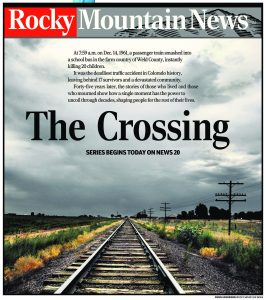
Colorado was still suffering the ramifications of the 1999 Columbine shooting. The far reaching story of The Crossing elicited a mass wave of empathy in the region. Vaughan’s emotive narrative had significant impact on the lives of people in Colorado in their identification with the terrible loss. Vaughan assumed his piece would live forever. Its digital presence would guarantee this. Or so he thought…
In 2008, Vaughan was named a finalist for the Pulitzer Prize for his work on the 34 part multimedia series. In 2009, the Rocky Mountain News went out of business, and the website followed soon after. The Crossing, and the tale it told, disappeared and fell victim to the passage of time once again.
“There’s this gradual trend toward more and more access, and of course electronic media provides the easiest and cheapest access to information that we’ve ever had on the planet…but it’s also the most easily lost. We’ve always had this tradeoff between permanence and accessibility.” ( Edward McCain, digital curator of journalism and founder of Dodging the Memory Hole at the Donald W. Reynolds Journalism Institute and University of Missouri Libraries.) ( “How To Preserve”)
Vaughan’s initial research had been conducted from work resurrected from dusty old boxes in forgotten warehouses. But with the collapse of the paper and resulting vanquish of the website, his own digital research and documentation disappeared without a trace.
Abbey Rumsey, writer and digital historian says, “There are now no passive means of preserving digital information. In other words if you want to save something online, you have to decide to save it. Ephemerality is built into the very architecture of the web, which was intended to be a messaging system, not a library.” (“Raiders”)
Six years after The Crossing disappeared, Vaughan re-introduced it to the Web. By serendipity alone, he had back-up. After the publishing of The Crossing, he had been asked to introduce some presentations on it, and had four DVDs made to serve this purpose. The series had been built using HTML4, and he had what he needed to rebuild the site. His son, who was studying electrical engineering and computer science at the time, took the project on, and rebuilt it according to the new standards and software now available.
Obsolescence is embedded into technology. When Sir Tim Berners-Lee formulated the web twenty years ago, he saw it as a forum for the good of mankind, where data was available for research, where all of this information could network and be democratized for the people of the world. But what we are seeing more and more of are useful ideas and research disappearing.
The problem lies in large with the fact that there is no one trusted digital vault into which content can be stored and used for future access. “Terms of service for nearly every free platform…make absolutely no promise regarding digital preservation or even the return of content to users in event of business failure or (elimination of) service.” (Elaine Harrington)
The obstacles are manifold: matters of privacy, staffing and skillsets, storage space, issues of access….The sheer volume of information we now produce is in direct competition with our capacity to preserve it and archive it for future use.
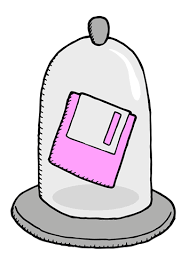
Coursera. “Why Is Digital Preservation Important?” Coursera (n.d.) Web. Nov. 2017.
Hare, Kristen. “How to Preserve Your Work Before the Internet Eats It.” Poynter, 14 Jan. 2016. Web. Nov. 2017.
Harrington, Elaine. “Preserving the Libraries of the Future.” Digital Humanities Research Colloquium, 18 Oct 2017, DH Active Learning Space, UCC. Guest Presentation.
LaFrance, Adrienne. “Raiders of the Lost Web. ” The Atlantic, 14 Oct. 2015. Web. Nov. 2017.
Special Collections Visit for DH 6033
Boole Library Visit, October 25, 2017
My introduction to UCC Special Collections took place on a rainy Tuesday evening in the basement of the Boole library. The role of Special Collections in Boole library is the conservation and care of the manuscripts, limited editions and rare pieces that are held within. It also offers a very special service in the guise of an archive and research facility for those interested in exploring these unique items further.
As an introduction, Special Collections Librarian Elaine Harrington guided our group through the Corke Journal, which was first published in 1753. The particular collection we were guided through dates from 1769 – 1772. Ms. Harrington pointed out binding techniques, ink peculiarities and typesetting specific to the journal and the time period.
I chose a seat randomly and found myself on a walk back down through the passage of time via the Kinsale Manorial Papers. The edition was arranged for Sir Robert Southwell and contains the Lord Roche Family papers, arranged chronologically. The papers date from 1607 – 1657.
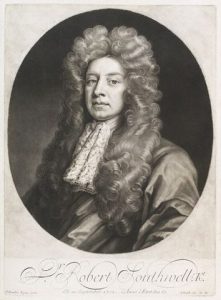
By Godfrey Kneller via Wikimedia Commons
The original papers are deceptively fragile in appearance. They are of varying size, and bound into more robust standard size leaves for the purpose of preservation and examination. The volume is remarkably light considering the substantial quality of the paper within and the fact that it is quite generous in size. What is immediately evident is the presence of a variety of authors. The scripts within range from being moderately legible to quite indecipherable for an inexperienced reader such as myself.
The introductory pages contain a family tree, and there are several more of these structures at stages throughout, perhaps marking the progression, growth and loss of the Roche family over the fifty years documented within. Throughout the pages also appear to be excerpts from ledgers, documents transferring property ownership, prices and land deeds.
Many of the original leaves are quite noticeably creased and brittle at their periphery. Upon closer inspection, I realized that these are instances of correspondence. On the reverse side of the pages remains evidence of sealing wax and forms of address in remarkably strong inked script. The fact that these letters remain in such outstanding condition considering their passage through the postal system of the time and often inclement weather of this part of the world is an aspect that I find particularly enthralling.
I very much relished this opportunity to explore such artefacts at close quarters. The issues of aura and my considerations on it continue to build and refine throughout my Digital Humanities journey as my personal experiences and acquaintances with such artefacts continue.
